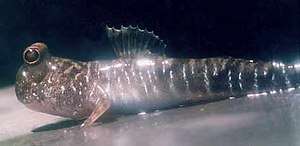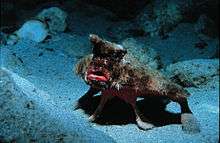Walking fish
A walking fish, is a fish that is able to travel over land for extended periods of time. Some other modes of non-standard fish locomotion include "walking" along the sea floor, for example, in handfish or frogfish.

Types
Most commonly, walking fish are amphibious fish. Able to spend longer times out of water, these fish may use a number of means of locomotion, including springing, snake-like lateral undulation, and tripod-like walking. The mudskippers are probably the best land-adapted of contemporary fish and are able to spend days moving about out of water and can even climb mangroves, although to only modest heights.[1] The climbing gourami is often specifically referred to as a "walking fish", although it does not actually "walk", but rather moves in a jerky way by supporting itself on the extended edges of its gill plates and pushing itself by its fins and tail. Some reports indicate that it can also climb trees.[2]
The epaulette shark (Hemiscyllium ocellatum) tends to live in shallow waters where swimming is difficult, and can often be seen walking over rocks and sand by using its muscular pectoral fins.[3] It lives in areas of great variation in water depth, usually where the tide falls below its location. If it finds itself out of water, it can survive for several hours, and is capable of walking over land to get to water. This means that it is easily observed by beachgoers in its natural range.
There are a number of fish that are less adept at actual walking, such as the walking catfish. Despite being known for "walking on land", this fish usually wriggles and may use its pectoral fins to aid in its movement. Walking catfish have a respiratory system that allows them to live out of water for several days. Some are invasive species, for example, the Northern snakehead in the U.S.[4] Polypterids have rudimentary lungs and can also move about on land, though rather clumsily. The mangrove rivulus can survive for months out of water and can move to places like hollow logs.[5][6][7]
Some species of fish can "walk" along the sea floor but not on land. One such animal is the flying gurnard (it does not actually fly, and should not be confused with flying fish). The batfishes of the family Ogcocephalidae (not to be confused with batfish of Ephippidae) are also capable of walking along the sea floor. Bathypterois grallator, also known as a "tripodfish", stands on three fins on the bottom of the ocean and hunts for food.[8] The African lungfish (P. annectens) can use its fins to "walk" along the bottom of its tank in a manner similar to the way amphibians and land vertebrates use their limbs on land.[9][10][11]
Evolutionary link

The theory of evolution suggests that life originated in the oceans and later moved onto land, and paleontologists have long been looking for transitional fossils between ocean-living and land-living animals. In 2006, a fossil Tiktaalik roseae was found which has many features of wrist, elbow, and neck that already begin to look similar to those of tetrapods.[12] It belongs to a group of lobe-finned fish called Rhipidistia, which according to some theories, were the ancestors of all tetrapods.
Comparison of fish with tetrapod-like features
A number of fish, both extant and prehistoric, have featured some characteristics related to locomotion that are typical of tetrapods.
| Species | venturing onto land | tetrapod-like spine | tetrapod-like appendages | digit-like bones | |||||||
|---|---|---|---|---|---|---|---|---|---|---|---|
| 5 axial regions | interlocking vertebrae | fully ossified vertebrae | shoulder & skull separation | functional 'intra-fin' joints | fins adapted for walking rather than swimming | strong & muscled fins | humerus, radius & ulna bones | differentiated distal radial bones | jointed distal radial bones | ||
| Panderichthys rhombolepis † | ? | No | No | No | No | ? | No | Yes | Yes | Yes[13] | No |
| Sauripterus taylori † | ? | No | No | No | No | ? | No | Yes | Yes | Yes | Yes[14] |
| Tiktaalik roseae † | ? | No | No | No | Yes | Yes | No | Yes | Yes | No | No |
| Tarrasius problematicus † | ? | Yes[15] | No | No | No | No | No | No | No | No | No |
| Leptolepis koonwarriensis † | ? | No | No | Yes[16] | No | No | No | No | No | No | No |
| Eastmanosteus pustulosus † | ? | No | No | No | Yes[17] | No | No | No | No | No | No |
| Atractosteus spatula | No | No | Yes | Yes[18] | No | No | No | No | No | No | No |
| Periophthalmus papilio | Yes | No | No | No | No | Yes[19][20] | No | No | No | No | No |
| Brachionichthys hirsutus | No | No | No | No | No | No | Yes | No | No | No | No |
| Ogcocephalus darwini | No | No | No | No | No | No | Yes | No | No | No | No |
| Antennarius maculatus | No | No | No | No | No | No | Yes | No | No | No | No |
| Protopterus annectens | Yes | No | No | No | No | No | ?[10] | No | No | No | No |
| Latimeria chalumnae | No | No | No | No | No | No | No | Yes | No | No | No |
| Polypterus bichir lapradei | Yes | No | No | No | No | No | No | Yes | No | No | No |
| Chelidonichthys cuculus | No | No | No | No | No | No | Yes (3 rays) | No | No | ? (3 rays) | No |
| Hemiscyllium ocellatum | Yes | No | No | No | Yes[21] | No | ?[22] | No | No | No | No |
Darwin fish
Another usage of the term walking fish is in reference to the "Darwin fish", a bumper sticker parody of the Ichthys, a symbol of Christianity.
Gallery
 An epaulette shark clambering over the sand on a beach
An epaulette shark clambering over the sand on a beach
See also
- Axolotl, colloquially known as a "walking fish"; it is not a fish, but an amphibian
- Evolution of fish
References
- "Tourism". Cairns Museum. Archived from the original on 1 February 2014. Retrieved 17 July 2011.
- "Climbing Fish". MSN Encarta. Archived from the original on 29 August 2009. Retrieved 16 July 2009.
- "Why Do Sharks Expose their Dorsal Fins?". elasmo-research.org.
- "Maryland Suffers Setback in War on Invasive Walking Fish", National Geographic News July 12, 2002
- Taylor, Anna-Louise (8 January 2012). "Shells, trees and bottoms: Strange places fish live". BBC Nature. Archived from the original on 8 June 2018. Retrieved 12 January 2012.
- "Tropical fish can live for months out of water". Reuters. 15 November 2007.
- Mehta, Aalok (6 November 2007). "Fish Lives in Logs, Breathing Air, for Months at a Time". nationalgeographic.com.
- Jones, AT; KJ Sulak (1990). "First Central Pacific Plate and Hawaiian Record of the Deep-sea Tripod Fish Bathypterois grallator (Pisces: Chlorophthalmidae)" (PDF). Pacific Science. 44 (3): 254–7.
- "Fish uses fins to walk and bound". 13 December 2011 – via www.bbc.co.uk.
- King, Heather M.; Shubin, Neil H.; Coates, Michael I.; Hale, Melina E. (12 December 2011). "Behavioral evidence for the evolution of walking and bounding before terrestriality in sarcopterygian fishes". Proceedings of the National Academy of Sciences. 108 (52): 21146–21151. Bibcode:2011PNAS..10821146K. doi:10.1073/pnas.1118669109. PMC 3248479. PMID 22160688 – via www.pnas.org.
- "A small step for lungfish, a big step for the evolution of walking". sciencedaily.com.
- Daeschler, E.B., Shubin, N.H. and Jenkins, Jr. F.A. (6 April 2006). "A Devonian tetrapod-like fish and the evolution of the tetrapod body plan". Nature. 440 (7085): 757–763. Bibcode:2006Natur.440..757D. doi:10.1038/nature04639. PMID 16598249.CS1 maint: multiple names: authors list (link)
- C. A. Boisvert, E. Mark-Kurik, P. E. Ahlberg (4 December 2008). "The pectoral fin of Panderichthys and the origin of digits". Nature. 456 (7222): 636–638. Bibcode:2008Natur.456..636B. doi:10.1038/nature07339. PMID 18806778.CS1 maint: uses authors parameter (link)
- E. B. Daeschler, N. H. Shubin (8 January 1998). "Fish with Fingers?". Nature. 391 (6663): 133. Bibcode:1998Natur.391..133D. doi:10.1038/34317.CS1 maint: uses authors parameter (link)
- Lauren Cole Sallan (23 May 2012). "Tetrapod-like axial regionalization in an early ray-finned fish". Proceedings of the Royal Society B. 279 (1741): 3264–3271. doi:10.1098/rspb.2012.0784. PMC 3385743. PMID 22628471.CS1 maint: uses authors parameter (link)
- Shukla, J.P. (2007). Fish & Fisheries. Rastogi Publications. pp. 24–25. ISBN 978-81-7133-800-9.
- K. Trinajstic et al. (12 July 2013). "Fossil Musculature of the Most Primitive Jawed Vertebrates". Science. 341 (6142): 160–164. Bibcode:2013Sci...341..160T. doi:10.1126/science.1237275. PMID 23765280.CS1 maint: uses authors parameter (link)
- Olsen, Stanley J. (1968). Fish, Amphibian and Reptile Remains from Archaeological Sites. Acme Bookbinding. p. 4. ISBN 978-0-87365-163-9.
- S. M. Kawano and R. W. Blob (August 2, 2013). "Propulsive Forces of Mudskipper Fins and Salamander Limbs during Terrestrial Locomotion: Implications for the Invasion of Land" (PDF). Integrative and Comparative Biology. 53 (2): 283–294. doi:10.1093/icb/ict051. PMID 23667046.CS1 maint: uses authors parameter (link)
- C. M. Pace and A. C. Gibb (July 15, 2009). "Mudskipper pectoral fin kinematics in aquatic and terrestrial environments". The Journal of Experimental Biology. 212 (14): 2279–2286. doi:10.1242/jeb.029041. PMID 19561218.CS1 maint: uses authors parameter (link)
- Hanken, James; Hall, Brian K. (1993). The Skull, Volume 2: Patterns of Structural and Systematic Diversity. University of Chicago Press. p. 209. ISBN 978-0-226-31570-6.
- Goto, T., Nishida, K. and Nakaya, K. (Sep 1999). "Internal morphology and function of paired fins in the epaulette shark, Hemiscyllium ocellatum". Ichthyological Research. 46 (3): 281–287. doi:10.1007/BF02678514.CS1 maint: uses authors parameter (link)
